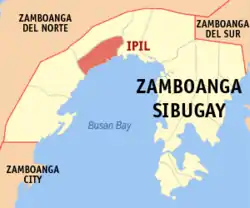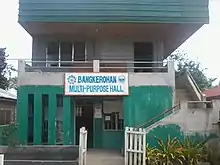Ipil, Zamboanga Sibugay
Ipil, officially the Municipality of Ipil (Cebuano: Lungsod sa Ipil; Chavacano: Municipalidad de Ipil), is a 1st class municipality and capital of the province of Zamboanga Sibugay, Philippines. According to the 2015 census, it has a population of 74,656 people. [3] It is the most populous municipality of Zamboanga Sibugay.
Ipil | |
|---|---|
| Municipality of Ipil | |
 Seal | |
Nickname(s):
| |
| Motto(s): Ipil: Our place, our responsibility, our pride! | |
 Map of Zamboanga Sibugay with Ipil highlighted | |
OpenStreetMap 
| |
.svg.png.webp) Ipil Location within the Philippines | |
| Coordinates: 7°47′00″N 122°35′00″E | |
| Country | |
| Region | Zamboanga Peninsula (Region IX) |
| Province | Zamboanga Sibugay |
| District | 2nd District |
| Founded | July 26, 1949 |
| Barangays | 28 (see Barangays) |
| Government | |
| • Type | Sangguniang Bayan |
| • Mayor | Anamel C. Olegario |
| • Vice Mayor | Ramses Troy D. Olegario |
| • Representative | Dulce Ann K. Hofer |
| • Electorate | 53,098 voters (2019) |
| Area | |
| • Total | 241.60 km2 (93.28 sq mi) |
| Elevation | 27 m (89 ft) |
| Population | |
| • Total | 74,656 |
| • Density | 310/km2 (800/sq mi) |
| • Households | 17,616 |
| Economy | |
| • Income class | 1st municipal income class |
| • Poverty incidence | 23.22% (2015)[4] |
| • Revenue | ₱211,632,367.77 (2016) |
| Time zone | UTC+8 (PST) |
| ZIP code | 7001 |
| PSGC | |
| IDD : area code | +63 (0)62 |
| Climate type | tropical climate |
| Native languages | Subanon Cebuano Chavacano Tagalog |
| Website | ipilsibugay |
Ipil is located three hours from the key cities in the region (Dipolog, Pagadian and Zamboanga City). The Ipil seaport is 4 kilometres (2 mi) south of the town center.
Ipil Airport is located at Barangay Sanito, along the Pan Philippine Highway, and it is the only airport in Zamboanga Sibugay.
History
Ipil used to be known as Sanito, a place under barrio Bacalan under the Municipality of Kabasalan. It was a swampy area and a docking spot for pioneering Ilocanos who settled in the upper areas of Titay. Ipil was a jumping point for their lantsa sailing to Zamboanga City. The first mayor of Ipil was Gregorio Dar, an Ilocano who came from Titay. The Dar Family were the second batch of Ilocanos who settled upon the invitation of Mariano Families who are among the first batch of Ilocanos from Luzon. When Sanito became a Town in 1949,[5] its name was changed to Ipil, as there were many Ipil trees found within the said locale.
Early Ilocano routes
The first Ilocanos used Ipil as the nearest jump point in connecting Titay with Zamboanga City. They would walk via Lumbia then to Longilog then Gabo reaching Mayabang their original settlement. It was this route that they do not have to cross the rivers as it is uphill. It was the Ilocanos who first set foot on these areas.
Ipil massacre
On the morning of April 3, 1995, Ipil was attacked by approximately 200 heavily armed Abu Sayyaf militants who fired upon residents, strafed civilian homes, plundered banks, took up to 30 hostages and then burned the centre of the town to the ground.[6][7]
The militants allegedly arrived in the town by boat and bus, and a number of them had been dressed in military fatigues
The town's Chief of Police was reportedly killed in the attack and close to a billion pesos were looted from eight commercial banks.[8] Army commandos pursued some rebel gunmen in nearby mountains while officials said that the rebels were looting farms and seizing civilians as "human shields" as they fled the town of [9] about 40 rebels, who may have taken hostages, were cornered in a school compound west of Ipil on the 6th of April when an elite army unit attacked. In the fighting that followed, the television station GMA reported, 11 civilians were killed.[9]
Local government
Climate
| Climate data for Ipil, Zamboanga Sibugay | |||||||||||||
|---|---|---|---|---|---|---|---|---|---|---|---|---|---|
| Month | Jan | Feb | Mar | Apr | May | Jun | Jul | Aug | Sep | Oct | Nov | Dec | Year |
| Average high °C (°F) | 31 (88) |
31 (88) |
31 (88) |
31 (88) |
30 (86) |
29 (84) |
29 (84) |
29 (84) |
29 (84) |
29 (84) |
30 (86) |
30 (86) |
30 (86) |
| Average low °C (°F) | 23 (73) |
23 (73) |
24 (75) |
24 (75) |
25 (77) |
25 (77) |
24 (75) |
24 (75) |
24 (75) |
24 (75) |
24 (75) |
23 (73) |
24 (75) |
| Average precipitation mm (inches) | 61 (2.4) |
55 (2.2) |
75 (3.0) |
81 (3.2) |
145 (5.7) |
189 (7.4) |
189 (7.4) |
197 (7.8) |
162 (6.4) |
181 (7.1) |
115 (4.5) |
70 (2.8) |
1,520 (59.9) |
| Average rainy days | 16.4 | 15.7 | 19.1 | 21.5 | 26.9 | 27.1 | 26.4 | 25.0 | 24.2 | 26.8 | 23.5 | 18.7 | 271.3 |
| Source: Meteoblue [12] | |||||||||||||
Barangays

Ipil is subdivided into 28 barangays.
- Bacalan
- Bangkerohan
- Buluan
- Caparan
- Domandan
- Don Andres
- Doña Josefa
- Guituan
- Ipil Heights
- Labe
- Logan
- Tirso Babiera (Lower Ipil Heights)
- Lower Taway
- Lumbia
- Maasin
- Magdaup
- Makilas
- Pangi
- Poblacion
- Sanito
- Suclema
- Taway
- Tenan
- Tiayon
- Timalang
- Tomitom
- Upper Pangi
- Veteran's Village
Demographics
| Year | Pop. | ±% p.a. |
|---|---|---|
| 1960 | 21,141 | — |
| 1970 | 32,478 | +4.38% |
| 1975 | 35,798 | +1.97% |
| 1980 | 43,540 | +3.99% |
| 1990 | 43,031 | −0.12% |
| 1995 | 43,991 | +0.41% |
| 2000 | 52,481 | +3.86% |
| 2007 | 60,686 | +2.02% |
| 2010 | 64,939 | +2.50% |
| 2015 | 74,656 | +2.69% |
| Source: Philippine Statistics Authority [3] [13] [14][15] | ||
Hospitals
- Zamboanga Sibugay Provincial Hospital
- Dr. Henry De Villa Memorial Hospital
- Dr. M. Simon Hospital
- Ipil Doctors Hospital
Media
Several radio stations operate in the area: dxLR- 98.1 FM, Flazh-FM 99.7, Hitz 98.9, Magic 103 FM, 94.3 dxIR FM, dxDS FM, Igsoon FM and Radyo Lipay AM; and several newspapers are published here, including the Zamboanga Sibugay Tribune and The Sibugay Express.
References
- Municipality of Ipil | (DILG)
- "Province: Zamboanga Sibugay". PSGC Interactive. Quezon City, Philippines: Philippine Statistics Authority. Retrieved 12 November 2016.
- Census of Population (2015). "Region IX (Zamboanga Peninsula)". Total Population by Province, City, Municipality and Barangay. PSA. Retrieved 20 June 2016.
- "PSA releases the 2015 Municipal and City Level Poverty Estimates". Quezon City, Philippines. Retrieved 12 October 2019.
- https://www.officialgazette.gov.ph/1949/07/26/executive-order-no-249-s-1949/
- "Troops seek killers of 53 in Philippines". Ocala Star-Banner. 12 April 1995. Retrieved 27 May 2013.
- "Gunmen raid Philippine town, 100 dead". Times-Union. Associated Press. 4 April 1995. Retrieved 27 May 2013.
- "VICTORIA CALAGUIAN: Photojournalist". L.A. Zamboanga Times. 22 December 2008. Retrieved 23 March 2010.
- "World News Briefs; Filipino Troops Corner Rebels After Attack". The New York Times. 7 April 1995. Retrieved 23 March 2010.
- "The Libi Board of Directors: As of December 31, 2017" (PDF). LBP Insurance Brokerage, Inc. Inter-Island Information Systems, Inc. Retrieved 15 August 2019.
- "LIST: Local bets who filed COCs on Day 5, October 17". Rappler. Rappler Inc. 19 October 2018. Retrieved 15 August 2019.
- "Ipil: Average Temperatures and Rainfall". Meteoblue. Retrieved 1 May 2020.
- Census of Population and Housing (2010). "Region IX (Zamboanga Peninsula)". Total Population by Province, City, Municipality and Barangay. NSO. Retrieved 29 June 2016.
- Censuses of Population (1903–2007). "Region IX (Zamboanga Peninsula)". Table 1. Population Enumerated in Various Censuses by Province/Highly Urbanized City: 1903 to 2007. NSO.
- "Province of Zamboanga Sibugay". Municipality Population Data. Local Water Utilities Administration Research Division. Retrieved 17 December 2016.
External links
| Wikimedia Commons has media related to Ipil, Zamboanga Sibugay. |